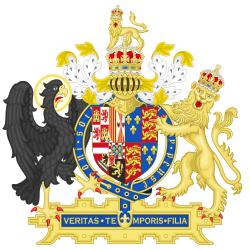Provisions
Section 1 to 6 – Protection of King Philip
The act provided legal protection to King Philip, who had married Queen Mary I on 25 July 1554 and became co-monarch of England and Ireland. It became an offence to "compass or imagine to deprive the King's Majesty from the having with the Queen the style, honour and kingly name, or to destroy the King, or to levy war within this realm against the King or Queen," or to say that the King ought not to have his title. The penalty for a first offence was forfeiture of goods and "perpetual imprisonment". A second offence was high treason. However to "compass or imagine the death of the King" or to remove him from government was high treason on a first offence.
The act also declared that if Mary died and her heir was not yet 18 if male, or was under 15 and unmarried if female, then Philip would govern the realm until the heir to the throne came of age (or was married, if female). In that event, it would be treason to "compass, attempt, and go about to destroy the person of the King, or to remove his Highness from the government".
Section 7 – Procedure
Section 7 of the act required trials for "any treason" (not just treason under this act) to be conducted in accordance with the common law, "and not otherwise".
Section 8 – Misprision of treason
Section 8 of the act provided that the concealment or keeping secret of treason constituted misprision of treason but not treason:
Provided always, and be it declared and enacted by the authority aforesaid, that concealment or keeping secret of any high treason be deemed and taken only misprision of treason, and the offenders therein to forfeit and suffer, as in cases of misprision of treason hath heretofore been used; any thing above mentioned to the contrary notwithstanding.
Sections 9 to 12 – Further procedure
Section 9 of the act preserved privilege of peerage — the right of peers of the realm to be tried by their peers. Section 10 stipulated that offences against the Act which were committed "only by preaching or words" must be prosecuted within six months.
Section 11 of the act created a new rule of evidence for cases of treason under the act (but not other treasons). It required all of the witnesses against the defendant (or at least two of them) to attend court to give evidence against him in person, "if living and within the realm". (The rule did not apply if the defendant pleaded guilty.) Different versions of this two witnesses rule were adopted in the Sedition Act 1661 (13 Cha. 2 St. 1. c. 1), the Treason Act 1695, and eventually in Article Three of the United States Constitution. The rule was first enacted in the Treason Act 1547. [2]
Section 12 of the act made similar provision to section 7.
Section 13 – Accessories
Section 13 of the act provided the rule for how accessories were to be treated for aiding and abetting a crime for which the penalty depended on whether it was the defendant's first or second offence. An accessory was to receive the same penalty as the principal offender, regardless of whether the accessory had committed the offence before.
Repeals
The whole act, except sections 6 and 8, was repealed on 28 July 1863 by section 1 of, and the schedule to, Statute Law Revision Act 1863.
The whole act was repealed on 1 January 1968 by section 10(2) of, and part I of schedule 3 to, the Criminal Law Act 1967.
This page is based on this
Wikipedia article Text is available under the
CC BY-SA 4.0 license; additional terms may apply.
Images, videos and audio are available under their respective licenses.


